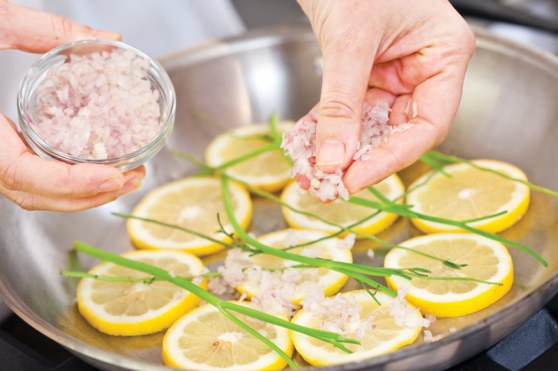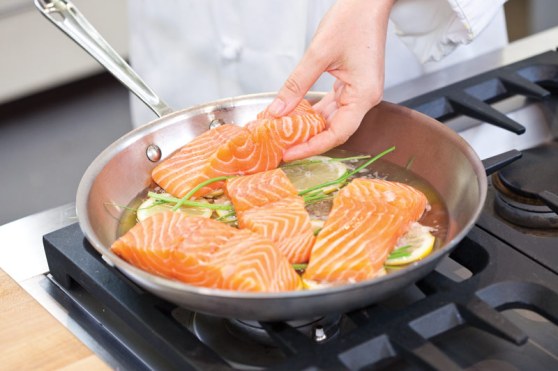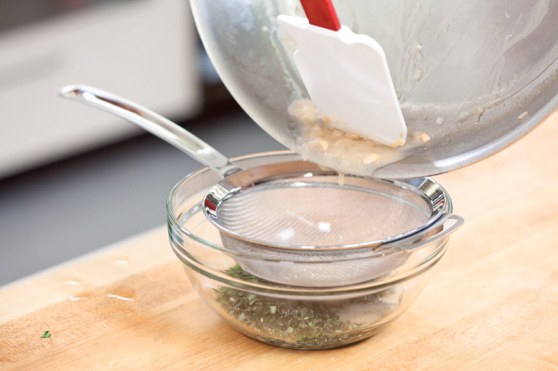WHY THIS RECIPE WORKS: Incorrectly poached salmon is dry, and the flavor is so washed out that not even the richest sauce can redeem it. We wanted irresistibly supple salmon, accented by the delicate flavor of the poaching liquid and accompanied by a simple pan sauce. Poaching the salmon in just enough liquid to come half an inch up its sides meant we didn’t need much to boost the flavor of the liquid. However, the part of the salmon that wasn’t submerged in liquid needed to be steamed for thorough cooking, and the low cooking temperature required to poach the salmon evenly didn’t create enough steam. By increasing the ratio of wine to water the additional alcohol lowered the liquid’s boiling point, producing more vapor even at the lower temperature. To keep the bottoms of the fillets from overcooking, we placed them on top of lemon slices. We reduced the poaching liquid and added some olive oil for an easy vinaigrette-style sauce. To ensure uniform pieces of fish that cooked at the same rate, we found it best to buy a whole center-cut fillet and cut it into four pieces ourselves.

SERVES 4
TOTAL TIME 45 MINUTES
2 lemons, 1 cut into 1/4‑inch-thick slices and 1 cut into wedges
2 tablespoons minced fresh parsley, stems reserved
2 tablespoons minced fresh tarragon, stems reserved
1 large shallot, minced
1/2 cup dry white wine
1/2 cup water
1 (1 3/4- to 2‑pound) skinless salmon fillet, about 1 1/2 inches thick
2 tablespoons capers, rinsed and minced
2 tablespoons extra-virgin olive oil
1 tablespoon honey
Salt and pepper
1. Arrange lemon slices in single layer in 12‑inch skillet. Top with parsley and tarragon stems and 2 tablespoons shallot. Add wine and water. Cut salmon crosswise into 4 fillets and lay, skinned side down, on lemon slices.
2. Set pan over high heat and bring liquid to simmer. Reduce heat to low, cover, and cook until center of salmon is still translucent when checked with tip of paring knife and registers 125 degrees (for medium-rare), 11 to 16 minutes.
3. Remove pan from heat. Using spatula, carefully transfer salmon and lemon slices to paper towel–lined plate. Tent salmon with aluminum foil.
4. Return pan with poaching liquid to high heat and simmer until liquid has reduced to 2 tablespoons, 4 to 5 minutes. Strain liquid through fine-mesh strainer into bowl. Whisk in minced parsley, minced tarragon, remaining shallot, capers, oil, and honey. Season with salt and pepper to taste.
5. Season salmon with salt and pepper. Using spatula, carefully transfer salmon, without lemon slices, to plates. Serve with sauce and lemon wedges.
LEARN HOW: Poached Salmon
Poaching rarely lives up to its promise to produce silken, delicately flavored fish. It typically requires prepping a slew of ingredients for the poaching broth, only to dump them down the drain at the end. And much of the salmon flavor leaches out of the fish and into the liquid. We solve both these problems by using a shallow poaching technique: Less poaching liquid means less ingredient prep (and waste), as well as less salmon flavor lost to the liquid. We finish our recipe by reducing the poaching liquid to add to our vinaigrette-style sauce, giving our salmon a serious flavor boost.

1. LINE THE PAN WITH LEMON SLICES: Arrange the lemon slices in a single layer over the bottom of a 12‑inch skillet and scatter the herb stems and shallot over the top.
WHY? The lemons help keep the salmon elevated off the surface of the skillet so that the fillets poach evenly. The herb stems and shallot add more flavor to the cooking liquid.

2. ADD WATER AND WINE: Add 1/2 cup each white wine and water to the skillet.
WHY? This small amount of liquid may seem meager compared with a classic poaching method (which submerges the fish in cups of simmering liquid), but using less liquid actually helps the fish cook more gently because the fish is steamed rather than simmered.

3. LAY THE SALMON FILLETS IN THE SKILLET: Pat the salmon dry and season with salt and pepper. Lay the fillets, skinned side down, on top of the lemons.
WHY? Placing the salmon skinned side down will leave the nonskinned side above the liquid, preserving the fillets’ appearance and making them more presentable. Be sure to use skinless salmon here or else the finished sauce will have a very strong flavor and an oily texture.

4. BRING THE LIQUID TO A SIMMER, REDUCE THE HEAT, AND COVER: Once the poaching liquid is simmering, turn down the heat, and cover the pan. Cook until the sides are opaque but the centers of the fillets are still translucent.
WHY? Turning down the heat allows the salmon to cook gently; covering the pan provides a consistent but gentle steaming environment, protecting the delicate fish.

5. LET THE SALMON DRAIN: Once the salmon is cooked through, transfer the fish and lemon slices to a paper towel–lined plate, cover with foil, and let the fillets drain while finishing the sauce.
WHY? If you skip this step, the fish will leak poaching liquid onto the plate, which makes a mess and waters down the sauce.

6. REDUCE, THEN STRAIN THE POACHING LIQUID: Return the pan with the poaching liquid to high heat and simmer until reduced to 2 tablespoons. Strain the reduced liquid, then add minced herbs, shallot, capers, oil, and honey to create a vinaigrette-style sauce.
WHY? The reduced poaching liquid is used as the “vinegar” in the sauce. Using the same liquid, the sauce is easy to make.
➜ View more recipes